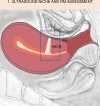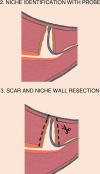Laparoscopic repair of the caesarean section scar niche: A prospective cohort study
- PMID: 40601781
- PMCID: PMC12220985
- DOI: 10.1371/journal.pone.0318592
Laparoscopic repair of the caesarean section scar niche: A prospective cohort study
Abstract
Objective: To evaluate the effect of laparoscopic repair of the large niche on short-term and long-term outcomes, i.e., extent of scar healing (increase in scar thickness or residual myometrium (RM) and decrease in niche depth), decrease in menstrual symptoms, likelihood of conception and successful delivery.
Study design: A prospective observational cohort study.
Methods and findings: Among 333 patients referred with a niche diagnosed in transvaginal ultrasound (TVU), a group of 127 met the selection criteria for repair surgery (RM of <2.5 mm in its thinnest part in hysterosonography (HySoG) and a desire to conceive) and underwent the laparoscopic procedure (uterine cesarean scar and niche walls cold knife resection followed by resuturing of the uterine wall) between November 2015 and October 2022. The laparoscopic repair of niche increased the RM to 6.5 ± 2.6 mm in TVU and 6.1 ± 2.5 mm in HySoG. Postoperative failure, defined as incomplete scar formation with a niche and residual myometrium thickness under 2.5 mm, occurred in 8.2% of cases. Furthermore, 20.9% of scars showed residual myometrium thickness below 4 mm. Conversely, the rate of postoperative diverticulum, defined as an indentation at the site of the cesarean section scar with a depth of at least 2 mm, was 70.9%. Furthermore, indentations greater than 3 mm were found in 49.1% of cases. The surgical procedure significantly alleviated symptoms related to the niche: duration of postmenstrual spotting (P < 0.001), length of menstrual bleeding (P = 0.03), menstrual pain (P < 0.001) and menstrual flow (P = 0.02). In patients with a sustained postoperatively desire to conceive (N = 79, 62.2%) a vast majority fulfilled childbearing plans (n = 42, 53.2%), for at least once (93%). The best surgical outcomes were obtained when the procedure was performed in the follicular phase of the menstrual cycle before the peri-ovulatory time (P = 0.02) and the uterine reconstruction was employed with double-layer horizontal mattress sutures.
Conclusions: The conducted study demonstrated that the surgical procedure for scar repair brings benefits by reducing clinical symptoms of the defect, improving scar parameters, and achieving a high rate of successful reproductive plans.
Copyright: © 2025 Abacjew-Chmylko et al. This is an open access article distributed under the terms of the Creative Commons Attribution License, which permits unrestricted use, distribution, and reproduction in any medium, provided the original author and source are credited.
Conflict of interest statement
The authors have declared that no competing interests exist.
Figures
Similar articles
-
Single- vs double-layer uterine closure of the cesarean scar in niche development: the Nicest Study.AJOG Glob Rep. 2025 Jun 4;5(2):100507. doi: 10.1016/j.xagr.2025.100507. eCollection 2025 May. AJOG Glob Rep. 2025. PMID: 40529188 Free PMC article.
-
Diagnostic yield of transvaginal ultrasonography versus saline: infused sonohysterography in the evaluation of post-cesarean section uterine niche.J Ultrasound. 2025 Mar;28(1):107-117. doi: 10.1007/s40477-024-00969-7. Epub 2024 Nov 18. J Ultrasound. 2025. PMID: 39556186
-
Risk of Cesarean scar defect following single- vs double-layer uterine closure: systematic review and meta-analysis of randomized controlled trials.Ultrasound Obstet Gynecol. 2017 Nov;50(5):578-583. doi: 10.1002/uog.17401. Epub 2017 Oct 9. Ultrasound Obstet Gynecol. 2017. PMID: 28070914
-
Cesarean scar niche repair with the rendez-vous technique: comparison of pre- and postoperative symptoms, sonographic findings and quality of life.Eur J Obstet Gynecol Reprod Biol. 2025 Jul 5;313:114566. doi: 10.1016/j.ejogrb.2025.114566. Online ahead of print. Eur J Obstet Gynecol Reprod Biol. 2025. PMID: 40651195
-
Emerging Manifestations of Cesarean Scar Defect in Reproductive-aged Women.J Minim Invasive Gynecol. 2016 Sep-Oct;23(6):893-902. doi: 10.1016/j.jmig.2016.06.020. Epub 2016 Jul 5. J Minim Invasive Gynecol. 2016. PMID: 27393285
References
-
- van der Voet LF, Bij de Vaate AM, Veersema S, Brölmann HAM, Huirne JAF. Long-term complications of caesarean section. The niche in the scar: a prospective cohort study on niche prevalence and its relation to abnormal uterine bleeding. BJOG. 2014;121(2):236–44. doi: 10.1111/1471-0528.12542 - DOI - PubMed
Publication types
MeSH terms
LinkOut - more resources
Full Text Sources
Medical
Miscellaneous




